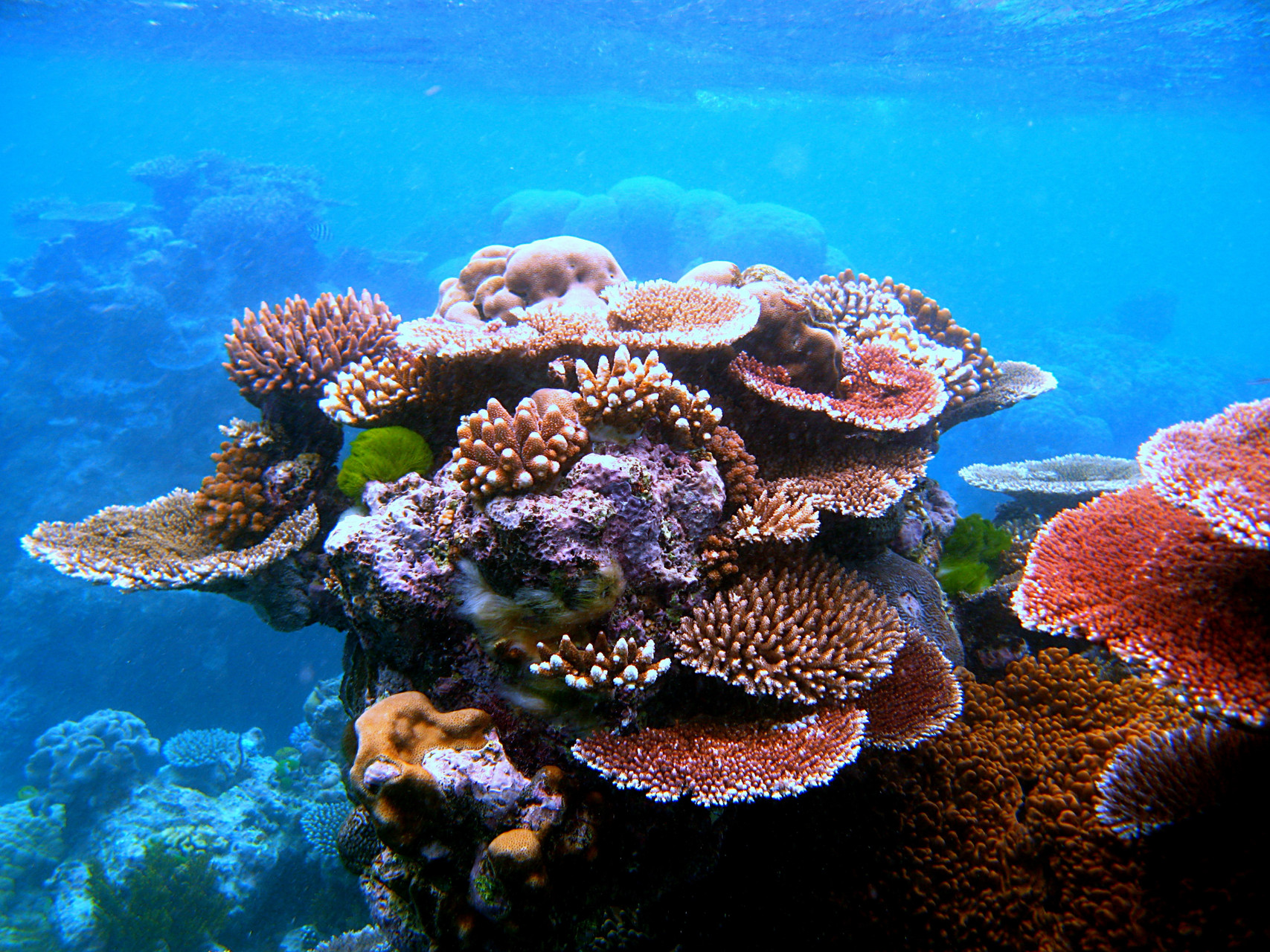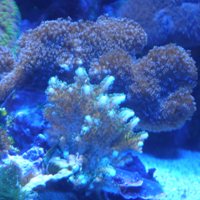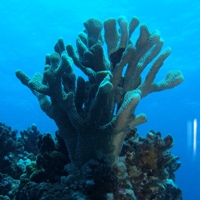Revisited: Coral Forms


It is no secret that corals come in a myriad of shapes. Just about everyone has seen a photo of a coral reef carpeted with spires, globes, and foliose contours. In fact, the mixture of structures is as characteristic a component of coral reefs as the coloration.
Coral species have evolved numerous formations, such as swirling, branching, or boulder-like structures, as a way of coping with their circumstances. That is, competition for space and light is stiff, and pounding waves and tides are potentially deadly. Nearly every square inch on a healthy reef is covered in coral polyps, encrusting algae, sponges, and other animals. In light of this fact, it is not surprising that competition is fierce and can even be lethal. The competition affects coral shapes as much as any other factor. Fascinatingly, a given species may exist in several distinctly different forms, depending on the individual colonys location and its surrounding opponents. For that reason, it is difficult to pigeon-hole one species into a single form.
Major Groups of Corals: Coral Taxonomy
Before discussing the shapes of coral colonies, it is useful to understand just exactly what we mean when we say coral. Corals are essentially colonial aggregations of polyps, and are related to jellyfish. Each polyp is really an individual animal with its own mouth and gut cavity. However, colonies often possess the ability to share nutrients amongst polyps by virtue of a network of connective tissue extending between mouths. While some colonies are in fact isolated individuals without connective tissue, each individual is an exact genetic clone of those around it. A given polyp consists of a tentacular crown, an oral disc, a mouth, mesenterial filaments, and a gut cavity. Corals also possess stinging cells in their tentacles called cnidocytes, which are typically used as a defense mechanism against predators and competitors.
In general, corals belong to either of two different classes of the phylum Cnidaria, Anthozoa or Hydrozoa. Anthozoans, including sea anemones, hard and soft corals, gorgonians, and blue, black, and organ-pipe corals, are the most familiar types. Class hydrozoa claims the lesser known fire corals and lace corals. Corals are further categorized by the presence or absence of symbiotic zooxanthellate algae, as well as the ability, or lack thereof, to deposit calcareous skeletons (hermatypic and ahermatypic, respectively). Zooxanthellate corals derive much of their nutrition from photosynthesis conducted by their symbiotic algae, but may feed on food particles suspended in the water column. On the other hand, corals lacking zooxanthellae must feed on particulate matter to stay alive (Interestingly, many anthozoans are obligate photosynthesizers, meaning they must possess zooxanthellae to survive. When they expel their algal symbionts, as during bleaching events, they die. However, some anthozoans, such as Aiptasia and some Anthopleura species can expel their algae and live in complete darkness!).
Most corals familiar to us are either scleractinian corals, which are commonly referred to as hard corals, or octocorals, collectively known as soft corals. In fact, the only true corals belong to the order Scleractinia, which excludes all octocorals and anemones. Scleractinian corals are the main hermatypic, or reef-building corals. Tropical species which photosynthesize are the colonial animals responsible for creating majestic coral reefs, but cold and/or deep water scleractinians exist as well. These corals deposit robust calcareous skeletons which provide support and protection for their polyps. When scleractinians die, their old skeletons comprise the substrate upon which new corals grow.
In some cases, octocorals can actually create as much as 50% of the biomass on a tropical reef. Other soft corals, like organ-pipe (Tubipora spp.) corals, also make minor contributions as reef-builders. Soft corals are popular aquarium species, as they are often hardy and colorful. Other octocorals, such as gorgonians and blue, black, and red corals are less prevalent as ornamentals, but are threatened by collection for the jewelry trade.
Coral Morphology:

MASSIVE/BOULDER-LIKE CORALS. Massive corals are, frankly, massive! Some can be as small as a cobblestone or as big as a house. Typically forming boulder-like formations, massive corals tend to live near the surface, in high-energy environments. Their huge, heavy skeletons ensure that they are not dislodged when wave-action is at its most ferocious. They may have a uniform, spherical shape which is relatively symmetrical. However, massive corals can also exhibit a knobby, amorphous appearance which is reminiscent of the surface of a gnarled old tree trunk. In general massive corals grow slowly, require high intensity light, and become more stable as they get larger.
Massive corals are formed out of a variety of genera, and some are even of interest in the aquarium trade. For instance, Montastrea Star Corals, Favidaae Pineapple and Brain Corals, and Moon Corals (Diploastrea heliopora) are all massive corals which are ornamentally available. Other ornamental examples include Porites and Platygyra specimens.
BRANCHING CORALS. Branching corals are most often varieties of small-polyped scleractinians (SPS) such as those in the genus Acropora. Branches can be robust like that of the Elkhorn coral, or delicate like those found on Staghorn and Birds Nest corals. Wave action determines the thickness of the branches, but the branching itself is a function of competition for light. Like a tree, branching corals have increased surface area for collecting light and outcompeting neighbors.
Branching SPS corals are some of the most colorful and sought-after corals in the aquarium trade. Of interest are specimens of the Acropora, Montipora, and Pocillopora genera.

COLUMNAR/PILLAR CORALS. Limited to the western Atlantic Ocean, pillar corals are of the genus Dendrogyra and are of little interest in the aquarium trade. They exhibit vertical clusters of digitate, or finger-shaped, branches which emerge from solid base. Growing to several meters tall, they can be quite large but do not possess secondary branches like acroporids. Interestingly, pillar corals extend their polyps during the day, which is unusual for SPS corals.
ENCRUSTING CORALS. Encrusting corals spread outward, creating a thin layer over existing hard substrates. At times, encrusting corals can take on a lumpy, amorphous appearance since the underlying substrate dictates the overall dimensionality. These types of coral are highly competitive in areas of heavy surf because vertical growth is very limited and they can withstand very intense radiation levels.
Typically, encrusting species are SPS corals. In the ornamental trade, Montipora and Montastrea are the genera of interest.
TABLE CORALS. Table corals are another morphological type formed by acroporids. Characterized by a slender vertical column which supports a single, flat expanse of skeleton, table corals can be several meters across. Their upper surface is densely covered with short, vertical projections which function to increase surface area for sunlight collection.

PLATE-LIKE/FOLIACEOUS CORALS. In fact, plate-like and foliaceous (leaf-like) corals are independent of one another, but I have grouped them here because of their similarities. Both have a series flattened, overlapping plates radiating out from a central point. Plate-like forms are flatter and have more rounded edges. Foliaceous corals, on the other hand, possess a wavier look, and bear superficial resemblance to leaves or flower-petals. Viewed from above, foliaceous corals appear to spiral outward in a continuous, expanding sheet. Generally, plate-like and leaf-like corals are fragile and grow deeper on the reef, away from turbulent waters. Often they are found on vertical walls, where there horizontally projecting plates allow them to reach out and collect passing sunlight.
SOFT CORALS. Soft octocorals, or leather corals, are characterized by the lack of a hard, calcareous skeleton. Many are known to create sharp skeletal shards within their tissues to protect against predation. The most common soft corals form finger-like, or digitate, projections which possess many small polyps. Soft corals can grow truly massive colonies, but are subject to breakage in heavy surf. Luckily for them, broken pieces can attach themselves to hard surfaces, thereby creating new colonies. Soft corals come in both zooxanthellate and non-zooxanthellate varieties.
Ornamental species include toadstool and finger leathers, daisy polyps, Xenia spp. , as well as mushroom corals (Mushrooms, such as Discosoma and Ricordea spp. , are not actually corals at all-they are much more closely related to anemones. However, they are commonly sold as soft corals, hence their inclusion here).
 FREE LIVING CORALS. Free living corals are so-called because they do not attach themselves to hard substrates. Instead, they tend to live on sandy bottoms. They may also live on the reef structure itself but are usually not secured. Free living corals are long-polyped scleractinians, and can live as colonial or singular animals. Often, these coral types are strikingly colorful, and exhibit large, fleshy polyps. Free-living species are zooxanthellate, hermatypic, and can also eat small, meaty morsels.
FREE LIVING CORALS. Free living corals are so-called because they do not attach themselves to hard substrates. Instead, they tend to live on sandy bottoms. They may also live on the reef structure itself but are usually not secured. Free living corals are long-polyped scleractinians, and can live as colonial or singular animals. Often, these coral types are strikingly colorful, and exhibit large, fleshy polyps. Free-living species are zooxanthellate, hermatypic, and can also eat small, meaty morsels.
Free living corals are popular in the aquarium trade because of their large polyps and amazing colors. Species of interest include Fungia plate corals, Euphylliads, Acanthophyllia and Cynarina button corals, elegans corals (Cataphyllia sp.), flowerpots (Goniopora and Alveopora spp..), and open brains (Trachyphyllia and Wellsophyllia spp..).
Works Cited:
Anonymous. Scleractinia. Wikipedia encyclopedia entry. 2010. URL: http://en.wikipedia.org/wiki/Scleractinia
Borneman, Eric. Do You Know Where Your Corals Are Coming From? Ecological Information for Aquarists From Coral Collection Areas in Indonesia. Advanced Aquarists Online Magazine. 2002. URL: http://www.advancedaquarist.com/issues/mar2002/fe...
Castro, Peter and Michael E. Huber. Marine Biology, Fifth Edition. McGraw Hill: Boston. 2005.
Deep Water Corals, What are They? South Atlantic Fishery Management Council; Habitat and Ecosystem Section. 2010. URL: http://www.safmc.net/ecosystem/HabitatManagement/...
Shimek, Ronald L. Marine Invertebrates. Neptune City: T.F.H Publications, 2004.
Thurman, Harold V. and Alan P. Trujilo. Introductory Oceanography, Tenth Edition. Pearson Prentice Hall: Upper Saddle River. 2004.
U.S. Department of Commerce; National Oceanic and Atmospheric Administration. What are Coral Reefs. 2009. URL: http://coris.noaa.gov/about/what_are/